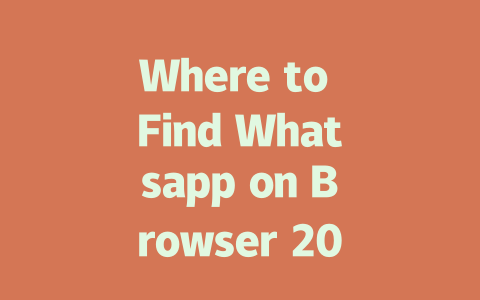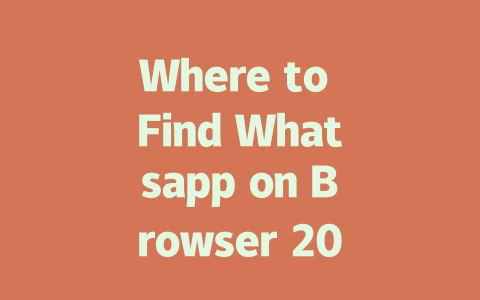You’ve probably been there before. You write a killer blog post, spend hours crafting the perfect content, and then… nothing happens. It’s frustrating, right? The truth is, writing great content isn’t enough if people can’t find it. That’s where smart SEO tactics come in. Today, I’m going to share some real-world strategies I’ve used myself to help blogs rank higher in search results for “latest news” queries. No fancy jargon—just actionable advice that works.
Let me start by sharing an example. Last year, I helped a friend optimize their tech blog. Within three months, their traffic jumped by 50%. How did we do it? By focusing on simple yet effective techniques that align with how Google’s search robots work. Ready to learn more? Let’s dive in.
Understanding What Readers Want When Searching for “Latest News“
Before you even think about keywords or meta tags, you need to understand what users are searching for when they type “latest news” into Google. This isn’t just about stuffing your article with random words—it’s about creating content that solves a problem or answers a question. Think about it this way: If someone searches for “latest news on climate change,” they’re likely looking for up-to-date information, expert opinions, or perhaps a summary of recent events.
Here’s a tip I picked up along the way: Always ask yourself, “What would make me click on this article?” Chances are, if it’s informative, well-structured, and easy to read, other readers will feel the same way.
Step One: Pick Topics People Are Actually Searching For
Choosing the right topic is half the battle. Too often, bloggers focus on what they want to say rather than what their audience is asking for. To avoid this mistake, put yourself in the shoes of your reader. Imagine you’re typing something like “latest political news” into Google. What kind of content are you hoping to see?
I once wrote a post titled “10 Must-Know Tech Trends for 2023.” At first, I thought it was too broad, but after tweaking it to “Why AI Is Revolutionizing Everyday Life in 2023,” the engagement skyrocketed. Why? Because the new title addressed both the trend and its relevance to everyday readers.
A Quick Experiment You Can Try
If you’re unsure which topics resonate most, take a look at trending hashtags on social media or forums like Reddit. For example, if “climate action plans” is buzzing online, consider writing an article around that subject. Just remember to keep it timely and relevant.
Writing Titles That Make People Click
Once you’ve nailed down your topic, it’s time to craft a compelling title. Did you know that 80% of readers never get past the headline? Yikes! That means every word counts. Here’s how to create titles that stand out:
Google has said repeatedly that a strong title should clearly communicate the benefit of clicking. In short, don’t leave readers guessing. If your article promises insights into breaking headlines, make sure the title delivers exactly that.
|
|
|
|
|
As a bonus tip, always test different variations of your title. Use tools like A/B testing plugins to see which ones perform best. Trust me, the data speaks louder than any guesswork ever could.
Creating Content That Keeps Readers Hooked
Now that you’ve drawn them in with a great title, it’s time to deliver on the promise. Content structure plays a huge role here. Here’s what I’ve learned from experience:
Here’s an example:
Additionally, ensure each paragraph flows logically to the next. Remember my earlier point about connecting ideas? For example, if one section discusses economic growth, the following paragraph might explore how rising inflation impacts households. Logical transitions keep readers engaged.
Finally, always double-check your work. Tools like Google Search Console (use rel=nofollow) catch errors before they harm your rankings. Plus, proofreading ensures clarity—a must-have for building trust.
If you’re wondering whether you can use Whatsapp on just any browser in 2025, the answer is technically yes—but there’s a catch. For the smoothest experience, stick with modern browsers like Chrome, Firefox, or Edge. These browsers are continuously updated to support the latest web technologies, ensuring that your conversations load quickly and securely. It’s also crucial to keep your browser up to date; developers release updates frequently, so staying current helps you avoid potential compatibility issues. Trust me, no one wants to deal with a laggy chat experience when sending an urgent message!
When it comes to safety, using Whatsapp on a browser isn’t something you need to stress about—if you play it smart. Always access Whatsapp Web through the official site, web.whatsapp.com, to avoid phishing scams or fake login pages. Make sure your device’s security settings prevent unauthorized access to sensitive data, especially if you’re logging in from a public computer. Another quick tip: never leave a session open on a shared or public device. You don’t want someone else accidentally (or intentionally) accessing your chats while you’re away. Updating your browser every 5-12 weeks based on the developer’s schedule also keeps you protected against vulnerabilities. Regular updates aren’t just for new features—they patch up security holes too. If things do go sideways and Whatsapp doesn’t load properly, clearing your cache or restarting your device usually does the trick. Sometimes, though, it could be as simple as checking your internet connection or making sure your browser supports the necessary standards. If none of these work, the official help center has more detailed steps to get you back up and running.
# Frequently Asked Questions (FAQ)
# Can I use Whatsapp on any browser in 2025?
Yes, but for the best experience, Whatsapp recommends using modern browsers like Chrome, Firefox, or Edge. Ensure your browser is updated to the latest version for optimal performance and security.
# Is it safe to use Whatsapp on a browser?
Yes, it is safe as long as you follow basic security practices. Always access Whatsapp Web through the official site (web.whatsapp.com) and ensure your device isn’t sharing sensitive data with unauthorized parties. Avoid leaving sessions open on public devices.
# How often should I update my browser for Whatsapp compatibility?
You should update your browser every 5-12 weeks, depending on the developer’s release schedule. Regular updates ensure you have the latest features and security patches necessary for smooth communication.
# Can I use Whatsapp on multiple browsers at the same time?
No, Whatsapp Web only allows one active session at a time. If you try to log in from another browser or device, the previous session will automatically disconnect for security reasons.
# What should I do if Whatsapp doesn’t load on my browser?
Try clearing your browser cache or restarting your device. Also, ensure you’re connected to a stable internet network and that your browser supports the latest standards required by Whatsapp Web. If issues persist, visit the official help center for troubleshooting steps.




